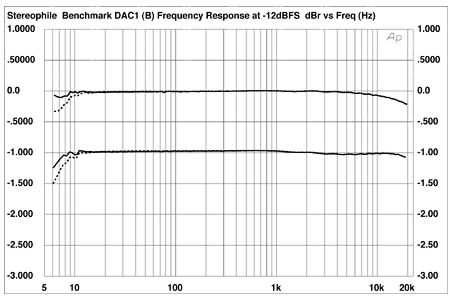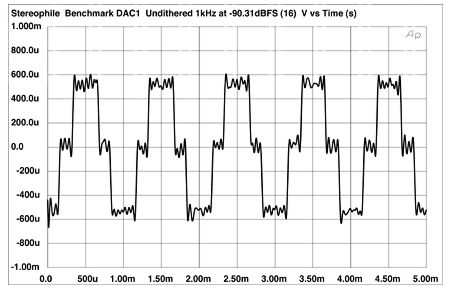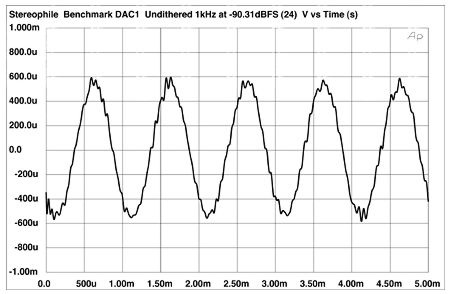| Columns Retired Columns & Blogs |
The Fifth Element #18 Measurements
Sidebar: Measurements
As is my wont when I write Follow-Ups on components previously covered in one of Stereophile's columns, I performed a full set of measurements on the DAC1. The maximum output level from the balanced jacks was a high 12.33V and a little less from the headphone jack, which clipped with a 0dBFS signal with the volume control set to its maximum. The unbalanced jacks delivered a full-scale 3.1V. All the outputs preserved absolute polarity, and the source impedance was a low 60 ohms from the balanced jacks, less than 1 ohm from the headphone output. The unbalanced source impedance was on the high side at 1230 ohms, but this should pose no problem with normal preamps.
Fed CD data, the DAC1's frequency response was flat over almost the entire audioband, from all three sets of outputs, with a very slight droop in the top octave (fig.1, top pair of traces). This rolloff continued up to 40kHz with 96kHz data before beginning a steeper decline (fig.2). Fed pre-emphasized data, the response (fig.1, bottom traces) was actually flatter than with normal data. With the volume control in-circuit, the DAC1's channel matching was excellent with the control at its maximum, though it worsened to a 1.25dB difference with the control at 12:00. Channel separation (fig.3) was better than 100dB below 2kHz, but worsened with increasing frequency at a 6dB/octave rate, due to the usual capacitive coupling, most probably at the volume control.

Fig.1 Benchmark DAC1, balanced frequency response at -12dBFS into 100k ohms, with de-emphasis (bottom) and without (top), 44.1kHz sample rate (right channel dashed, 0.5dB/vertical div.).

Fig.2 Benchmark DAC1, balanced frequency response at -12dBFS into 100k ohms, 96kHz sample rate (right channel dashed, 0.5dB/vertical div.).

Fig.3 Benchmark DAC1, channel separation.
Despite its affordable price, the DAC1 offers extraordinary resolution. This can be seen in fig.4. The top pair of traces are a 1/3-octave spectral analysis of the Benchmark's balanced output while it was fed 16-bit data representing a dithered 1kHz tone at -90dBFS. No harmonic components can be seen, and the noise floor is basically that of the recorded dither. Extending the word length to 24 bits (middle traces) drops the noise floor by almost 20dB, suggesting that the DAC1's resolution approaches 20 bits, which is superb. Undoubtedly this was aided by the higher-than-normal output level, but even feeding the Benchmark a dithered 24-bit tone at -120dBFS gave a recognizable spectrum, with no harmonics apparent (fig.4, bottom traces). However, note the spectral components at 300Hz and 650Hz with this signal. Idle tones of some kind?

Fig.4 Benchmark DAC1, 1/3-octave spectrum of dithered 1kHz tone at -90dBFS, with noise and spuriae, 16-bit (top) and 24-bit data (middle); and at -120dB, 24-bit data (bottom). (Right channel dashed.)
Correlating with this high dynamic range is a superbly low level of linearity error, even with 16-bit data (fig.5), while the DAC1's reproduction of an undithered 16-bit, 1kHz tone at exactly -90.31dBFS was essentially perfect, the three discrete voltage levels clearly defined and accompanied by excellent waveform symmetry (fig.6). Extending the word length to 24 bits gave an excellent sinewave shape (fig.7), even without dither.

Fig.5 Benchmark DAC1, balanced departure from linearity, 16-bit CD data (2dB/vertical div., right channel dashed).

Fig.6 Benchmark DAC1, waveform of undithered 1kHz sinewave at -90.31dBFS, 16-bit external data.

Fig.7 Benchmark DAC1, waveform of undithered 1kHz sinewave at -90.31dBFS, 24-bit CD data.
The Benchmark's excellent digital performance was matched in the analog domain. Fig.8 shows a spectral analysis of the headphone output outputting a full-scale 1kHz tone. With the exception of the second harmonic in the right channel at -106dB (0.0005%), the distortion components all lie at or below the analyzer's background level. The same excellent story can be seen with intermodulation distortion (fig.9).

Fig.8 Benchmark DAC1, headphone output, spectrum of 1kHz sinewave, DC-1kHz, at 0dBFS into 8k ohms, CD data (linear frequency scale).

Fig.9 Benchmark DAC1, headphone output, HF intermodulation spectrum, DC-25kHz, 19+20kHz at 0dBFS into 8k ohms, CD data (linear frequency scale).
Finally, even when fed via a high-jitter TosLink connection from my PC, the DAC1's rejection of word-clock jitter was excellent, with the 24-bit jitter level, assessed with the Miller Audio Research Analyzer, just 128.5 picoseconds peak-peak (fig.10). Data-related jitter was absent, and the highest-level pair of sidebands in this graph lie at ±15.6Hz (purple "1").—John Atkinson

Fig.10 Benchmark DAC1, high-resolution jitter spectrum of analog output signal (11.025kHz at -6dBFS, sampled at 44.1kHz, with LSB toggled at 229Hz). Source: 24-bit WAV file sourced from a PC with an RME Digi96/8 Pro soundcard and a Toslink connection. Center frequency of trace, 11.025kHz; frequency range, ±3.5kHz.
- Log in or register to post comments




































